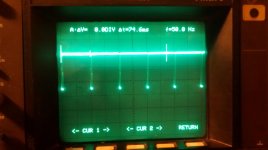acollins22
Experienced Member
Hello everyone.
I was recently given a 4032 that was working when it went into storage but isn't now and I'm trying to get it going.
It powers up with a very bingly-beep sound and produces a raster on the screen but no more than that. I've checked the 5v line and that's fine. The phi2 clock has a sawtooth wave on it. Not sure if that's good but it's something. Other pins on the 6502 are moving about. I watched A0 and A1 and they are twinkling as they should.
Looking on the video connector shows nothing but what is apparently a sync signal. Looking at the Technical manual it is the “Hor Drive” and it's at 500ns.
There is no signal on the Vert drive.
I'm a software guy by trade and not intuitive with hardware. I have a 'scope and general knowledge of how to use it but don't know what to check.
Please can someone tell me what to check next?
Thank very much.
Andy.
What does this all mean?
I was recently given a 4032 that was working when it went into storage but isn't now and I'm trying to get it going.
It powers up with a very bingly-beep sound and produces a raster on the screen but no more than that. I've checked the 5v line and that's fine. The phi2 clock has a sawtooth wave on it. Not sure if that's good but it's something. Other pins on the 6502 are moving about. I watched A0 and A1 and they are twinkling as they should.
Looking on the video connector shows nothing but what is apparently a sync signal. Looking at the Technical manual it is the “Hor Drive” and it's at 500ns.
There is no signal on the Vert drive.
I'm a software guy by trade and not intuitive with hardware. I have a 'scope and general knowledge of how to use it but don't know what to check.
Please can someone tell me what to check next?
Thank very much.
Andy.
What does this all mean?



